人教课标版高中英语必修3Unit2_词汇课_名师教学设计(一)
- 格式:doc
- 大小:61.50 KB
- 文档页数:8
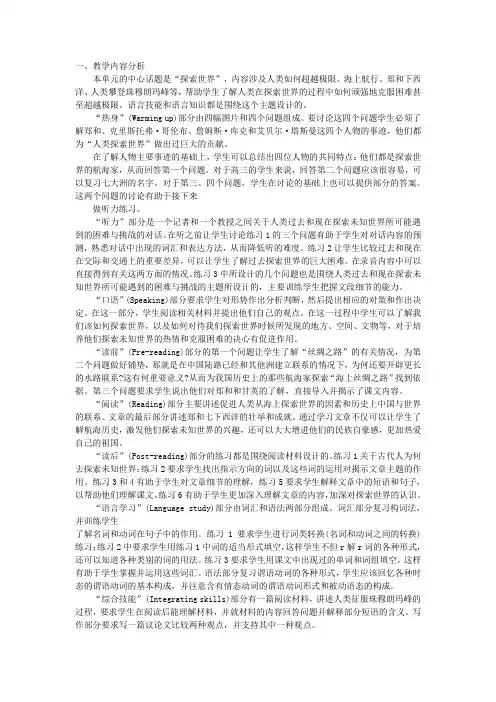
一、教学内容分析本单元的中心话题是“探索世界”,内容涉及人类如何超越极限、海上航行、郑和下西洋、人类攀登珠穆朗玛峰等,帮助学生了解人类在探索世界的过程中如何顽强地克服困难甚至超越极限。
语言技能和语言知识都是围绕这个主题设计的。
“热身”(Warming up)部分由四幅图片和四个问题组成。
要讨论这四个问题学生必须了解郑和、克里斯托弗·哥伦布、詹姆斯·库克和艾贝尔·塔斯曼这四个人物的事迹,他们都为“人类探索世界”做出过巨大的贡献。
在了解人物主要事迹的基础上,学生可以总结出四位人物的共同特点:他们都是探索世界的航海家,从而回答第一个问题。
对于高三的学生来说,回答第二个问题应该很容易,可以复习七大洲的名字。
对于第三、四个问题,学生在讨论的基础上也可以提供部分的答案。
这两个问题的讨论有助于接下来做听力练习。
“听力”部分是一个记者和一个教授之间关于人类过去和现在探索未知世界所可能遇到的困难与挑战的对话。
在听之前让学生讨论练习1的三个问题有助于学生对对话内容的预测,熟悉对话中出现的词汇和表达方法,从而降低听的难度。
练习2让学生比较过去和现在在交际和交通上的重要差异,可以让学生了解过去探索世界的巨大困难。
在录音内容中可以直接得到有关这两方面的情况。
练习3中所设计的几个问题也是围绕人类过去和现在探索未知世界所可能遇到的困难与挑战的主题所设计的,主要训练学生把握文段细节的能力。
“口语”(Speaking)部分要求学生对形势作出分析判断,然后提出相应的对策和作出决定。
在这一部分,学生阅读相关材料并提出他们自己的观点。
在这一过程中学生可以了解我们该如何探索世界,以及如何对待我们探索世界时候所发现的地方、空间、文物等,对于培养他们探索未知世界的热情和克服困难的决心有促进作用。
“读前”(Pre-reading)部分的第一个问题让学生了解“丝绸之路”的有关情况,为第二个问题做好铺垫,那就是在中国陆路已经和其他洲建立联系的情况下,为何还要开辟更长的水路联系?这有何重要意义?从而为我国历史上的那些航海家探索“海上丝绸之路”找到依据。
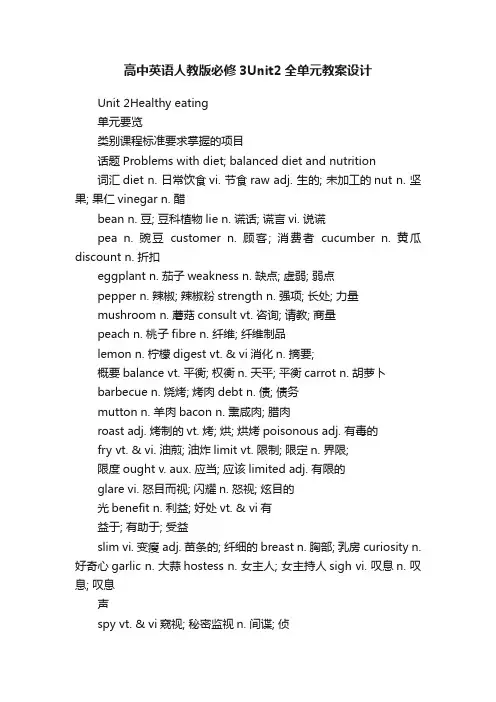
高中英语人教版必修3Unit2全单元教案设计Unit 2Healthy eating单元要览类别课程标准要求掌握的项目话题Problems with diet; balanced diet and nutrition词汇diet n. 日常饮食vi. 节食raw adj. 生的; 未加工的nut n. 坚果; 果仁vinegar n. 醋bean n. 豆; 豆科植物lie n. 谎话; 谎言vi. 说谎pea n. 豌豆customer n. 顾客; 消费者cucumber n. 黄瓜discount n. 折扣eggplant n. 茄子weakness n. 缺点; 虚弱; 弱点pepper n. 辣椒; 辣椒粉strength n. 强项; 长处; 力量mushroom n. 蘑菇consult vt. 咨询; 请教; 商量peach n. 桃子fibre n. 纤维; 纤维制品lemon n. 柠檬digest vt. & vi消化n. 摘要;概要balance vt. 平衡; 权衡n. 天平; 平衡carrot n. 胡萝卜barbecue n. 烧烤; 烤肉debt n. 债; 债务mutton n. 羊肉bacon n. 熏咸肉; 腊肉roast adj. 烤制的vt. 烤; 烘; 烘烤poisonous adj. 有毒的fry vt. & vi. 油煎; 油炸limit vt. 限制; 限定n. 界限;限度ought v. aux. 应当; 应该limited adj. 有限的glare vi. 怒目而视; 闪耀n. 怒视; 炫目的光benefit n. 利益; 好处vt. & vi有益于; 有助于; 受益slim vi. 变瘦adj. 苗条的; 纤细的breast n. 胸部; 乳房curiosity n. 好奇心garlic n. 大蒜hostess n. 女主人; 女主持人sigh vi. 叹息n. 叹息; 叹息声spy vt. & vi窥视; 秘密监视n. 间谍; 侦探combine vt. & vi. (使)联合; (使)结合短语balanced diet平衡膳食in debt欠债ought to应该; 应当spy on暗中监视; 侦查lose weight体重减轻; 减肥cut down削减; 删节get away with被放过; (做坏事)不受惩罚before long不久以后tell a lie说谎put on weight增加体重win. . . back赢回; 重新获得be amazed at对……感到吃惊earn one’s living谋生compete with与……竞争重要句型1. Wang Peng sat in his empty restaurant feeling very frustrated. (present participle used as adverbial)2. By now his restaurant ought to be full of people. (ought to)3. Nothing could have been better. (could have done)4. Something terrible must have happened if Li Chang was not coming to eat in his restaurant as healways did. (must have done)5. He could not have Yong Hui getting away with telling people lies! (can’t/couldn’t have sb. doing)功能What should we do? Shall we. . . ? How about. . . ?Y ou must/mustn’t. . . . I think you ought to. . . . Perhaps you should. . . .You’d better. . . . You need/needn’t. . . . You have to/don’t have to. . . .My advice is/would be. . . . You might. . . . I suggest that you. . . .I would strongly advise you to. . . . It might be a good idea to. . . .2. Seeing the doctorWhat’s the matter? What’s wrong with you?What seems to be the trouble? How long have you been like this?It’s nothing serious, only. . . . I suppose you had better. . . .I think you ought to. . . .3. Agreement and disagreementI’m not sure that! You could be right, but. . . .(I’m afraid)I don’t agree. I agree up to a point, but. . . .That’s an interesting idea, but. . . . Do you really think. . . ?Rubbish! /Nonsense! You can’t be serious!Actually/As a matter of fact, I think. . . . That’s not how I see it.语法Modal verbs: ought to/ought not tohave to/don’t have to/mustn’t/needn’t教学重点1. Get students to know about problems with a diet, a balanced diet and nutrition.2. Have students learn useful new words and expressions in this unit.3. Enable students to grasp and use the expressions of giving suggestions and advice.4. Let students learn the new grammar item: the use of ought to.5. Develop students’ listening, speaking, reading and writing abilities.6. Have students learn how to deal with and solve problems correctly.教学难点1. Enable students to master the use of ought to.2. Have students learn how to give suggestions and advice.3. Let students learn to write a short passage to make an advertisement.4. Develop students’ integrative s kills.课时安排Periods needed: 7Period 1 Warming up and readingPeriod 2 Learning about language: Important language points Period 3 Learning about language: GrammarPeriod 4 Using language: Listening and speakingPeriod 5 Using language: Extensive readingPeriod 6 Using language: Speaking and writingPeriod 7 Revision: Summing up and learning tip Period 1Warming up and reading整体设计教材分析This is the first teaching period of this unit. At the beginning of the class, the teacher can lead in the topic of the unit by showing students some pictures about foods and talking about them.Warming Up is to tell students how different kinds of food are grouped. This is important as it enables us to talk about the value of particular foods to our health. We want students to appreciate what a balanced diet is. T oo much fatty food will mean they store extra energy in their bodies. Too much body-building food may cause problems for digestion and lead to illness unless enough fibre foods are eaten to aid digestion. The teacher can have a free talk with students, let them work in pairs to read through the chart and discuss the questions.Pre-reading contains two more general questions about food for discussion. Students can be encouraged to discuss these questions in pairs. Then they are asked to look at the title of the reading passage and the pictures to predict what the passage isabout. This part is very useful for the next part Reading.The reading passage Come and Eat Here(1)introduces students to two unbalanced diets through the restaurants of Wang Peng and Yong Hui. Food at Wang Peng’s restaurant contains too much fat while Yong Hui’s restaurant offers little energy-giving food. The person who often eats at Wang Peng’s restaurant will become too fat. That can lead to illnesses such as a heart attack or high blood pressure. The person who often eats at Yong Hui’s restaurant will become too thin and suffer illnesses such as anorexia or malnutrition. It is important for students to know about the two extremes and avoid them. The teacher can encourage students to skim for the general idea and scan for further understanding. Because this passage introduces a lot of new words, which are only used for food, in order not to let students feel much difficult, the teacher should deal with any language problems while they are reading. After reading, students are required to do the exercises in Comprehending to see how much they have understood the reading passage. The teacher can let them work in pairs or in groups to find the answers cooperatively, and then checktheir answers with the whole class.To consolidate the contents of the reading passage, students should be required to read the passage again and then retell it. In order to arouse their interest, the teacher can hold a competition. The teacher also needs to make a summary on the passage including the general idea, writing characteristics, and so on to let students understand the passage further at the end of the class.教学重点1. Let students learn more about problems with a diet, abalanced diet and nutrition.2. Get students to learn different reading skills.教学难点1. Develop students’ reading ability.2. Enable students to talk about different kinds of food and balanced diet.三维目标知识目标1. Get students to learn the useful new words and expressions in this part: diet, nut, bean, pea, cucumber, eggplant, pepper, mushroom, peach, lemon, balance, barbecue, mutton, roast, fry, ought, bacon, slim, curiosity, hostess, raw, vinegar, lie, customer, discount, balanced diet, ought to, lose weight, get away with, tell a lie, win. . . back.2. Let students learn the knowledge of balanced diet and nutrition.能力目标1. Develop students’ reading ability and let them learn differen t reading skills.2. Enable students to talk about different kinds of food, problems with diet and balanced diet.情感目标1. Stimulate students’ sense to form a healthy eating habit.2. Develop students’ sense of cooperative learning.教学过程设计方案(一)→Step 1 Le ading-inHave a free talk with students. Ask them the following questions:1. Everybody has to eat, but do you eat a healthy diet?2. What do you usually have for breakfast/lunch/supper?3. What kind of food do you like best?4. Why are you so strong/weak/fat/thin? Does it have anything to do with your diet?5. Do you think you are eating a balanced diet?→Step 2 Warming up1. Let students turn to Page 9. Ask them to look at the pictures, name the foods in them and then fill in the form.Healthy food Unhealthy food2. Show the following on the screen. Let students read the question and the information about food in the form below.Do you know that the food you eat helps you grow in different ways?Food that provides energy(e.g. energy-giving food) Food that helps grow bonesand muscles(e. g.body-building food)Food that helps the body fight diseases(e. g.protective food)rice noodles spaghetti meat eggs cheese Most vegetables(e.g. beans, peas, cucumbers,bread potatoes chocolate butter cream oils nuts milktofu eggplants, peppers, mushrooms, cabbages)andfruit(e. g. apples, peaches, oranges, lemons)3. Ask students to work in pairs to discuss the following questions and then one of them tells their ideas to the class.Questions:1)Which groups of food do you like best?2)Which do you eat most often?3)Do you eat the three kinds of food each day?3)What will happen to you if you don’t eat a balanced diet?→Step 3 Pre-reading1. Let students discuss the following question:What do you think should go into a good meal?2. Ask students to imagine they are going to invite some friends for dinner. Let them discuss the question: What special food of your place would you offer them? Then have them plana menu.3. Let students turn to Page 10, look at the title of the reading passage and the pictures and predict what the passage is about. Then have them read the passage quickly to see if they are right.→Step 4 Reading1. Fast readingAsk students to skim the reading passage and then answer the following questions:1)Who are mentioned in the story?2)Where did the story happen?Three minutes later, check the answers with the whole class.Suggested answers:1)Wang Peng, Yong Hui and Li Chang.2)It happened in the two restaurants: Wang Peng’s restaurant and Yong Hui’s restaurant.2. Intensive readingAllow students to read the passage carefully this time to understand the main idea of each paragraph and the important details, and then finish the following:1)Choose the best answer to each question according to the text.(1)What did Wang Peng think of the food in his restaurant?A. Very bad.B. Just so-so.C. Unpopular.D. Popular.(2)What did Wang Peng do after he saw his friend Li Chang hurrying by?A. He just sat in his restaurant felling frustrated.B. He did some research.C. He followed Li Chang to see why he didn’t eat with him.D. He began to advertise his food.(3)Which of the following was not mentioned on Yong Hui’s menu?A. Apples.B. Cola.C. Water.D. Cabbages.(4)Which of the following did Wang Peng not do to win his customers back?A. He improved his food.B. He advertised his food.C. He did some research.D. He found the shortcomings of Yong Hui’s food.Suggested answers: (1)D(2)C(3)B(4)A2)Use the information from the reading passage to tick out the correct statements and give reasons for your answers.(1)Usual ly Wang Peng’s restaurant was full of people.(2)Yong Hui could make people thin in two weeks by giving them a good diet.(3)Wang Peng’s regular customers often become fat.(4)Yong Hui’s menu g ave customers more energy-giving food.(5)Wang Peng’s menu gav e customers more protective food.(6)Wang Peng decided to compete with Yong Hui by copying her menu.3)The passage can be divided into 3 parts. Give the main idea in each part.Part Main ideaPart 1Part 2Part 33. Reading and discussionRead the passage a third time and then work in pairs to do the following:1)Write out your answers.(1)The weakness of the diet in Wang Peng’s restaurant was that it did not give ______________.(2)The st rength of the diet in Wang Peng’s restaurant was that it provided ______________.(3)The weakness of the diet in Yong Hui’s restaurant was that it did not give ______________.(4)The strength of the diet in Yong Hui’s restaurant was that it provided ______________.2)Discuss these questions. Write down your main points and compare them with those of another pair.(1)What do you think Wang Peng will provide to win his customers back?(2)How do you think the story will end?(Let students have enough time to read the passage carefully and discuss the questions with their partners. Encourage them to expand their answers according to their own experiences. )4. ExplanationHelp students analyze some difficult, long and complex sentences and guess the meanings of some new words. Encourage them to try to deal with the language points in the context.Discuss and explain in your own words the following important sentences or parts of sentences taken from the passage.1)Wang Peng sat in his empty restaurant feeling very frustrated.2)Nothing could have been better.3)Something terrible must have happened if Li Chang was not coming to eat in his restaurant as he always did.4)He could not have Yong Hui getting away with telling people lies!5)Perhaps with a discount and a new sign he could win his customers back.5. Reading aloud and underliningAsk students to read the passage aloud to the tape and let them pay attention to the pronunciation of each new word and the pauses within each sentence. T ell them to pick out all the useful expressions or collocations from the passage while reading and copy them to the notebook after class as homework.Collocations: sit in his empty restaurant, feel very frustrated, a very strange morning, prepare his menu, by lunchtime, by now, ought to, be full of, be made of, Nothing could be better. , hurry by, follow sb. into. . . , lose weight, be fit, be amazed at, more than, a good meal, get away with, had better, do some research, too much, even though, energy-giving food, feel more hopeful, win. . . back, be on→Step 5 ConsolidationAsk students to talk about the problems with the diet in Wang Peng’s restaurant and Yong Hui’s restaurant in their own words according to the text. Then let them retell the whole story.→Step 6 Homework1. Learn the useful new words and expressions in this part by heart.2. Read the reading passage again and try to retell the story.设计方案(二)→Step 1 Leading in the topic1. Learning some vocabulary connected with food and diet.2. Identifying different groups of food.→Step 2 Warming up by making a surveyLet students interview their teachers and classmates on their diet and fill in the table.Name Breakfast Lunch Supper Favorite food The reason for beingstrong/weak/fat/thin→Ste p 3 Predicting by looking and discussing1. Look at the pictures and title of the reading passage and discuss in pairs what the passage might be about.2. Two or three students will give their opinions.3. Let them read the passage quickly to see if they are right.→Step 4 Reading1. Give students 2 minutes, and ask them to skim the passage for the general idea of the passage.2. Give students 5 minutes to read the passage carefully, and answer the following questions.1)What makes a balanced diet?2)What is wrong with the diet of both Wang Peng and YongHui?3)Why does it matter if you only eat at Wang P eng’s or Yong Hui’s restaurant?3. Give students 4 minutes to read the passage a third time. Encourage them to try to deal with the language points in the context. Then let them answer the following questions.1)What does the word “frustrated” mean in Para graph 1?2)How do you understand the sentence “Nothing could have been better”?3)What does the phrase “get away with” mean?4. Listening and reading aloudPlay the tape of the text for students and let them pay attention to the pronunciation of each new word and the pauses within each sentence. Then ask them to read the text aloud to the tape.→Step 5 DiscussionAsk students to work in pairs to discuss and compare the two restaurants. Try to find out the strength and weakness of each to fill in the chart.Wang Peng’s restaurant Yong Hui’s restaurant StrengthWeakness→Step 6 ExtensionLet students think about and discuss the following questions.1)Wha t do you think will happen to Wang Peng’s restaurant?2)In your opinion, what kind of food should we eat?3)Can you make a balanced diet for yourself?→Step 7 Closing down by retelling the story1. Have students get prepared in 3 minutes or so and then ask them to retell the story.2. Ask as many students as possible to have a try in front of the class.→Step 8 Homework1. Go over the text and try to learn all the useful words and expressions in this part by heart.2. Finish the exercises in Comprehending on Page 11.板书设计Unit 2Healthy eatingCome and eat here(1)True or false Key sentences1. Usually Wang Peng’s restaurant was full ofpeople.2. Yong Hui could make people thin in two weeksby giving them a good diet.3. Wang Peng’s regular customers ofte n becomefat.4. Yong Hui’s menu gave customers moreenergy-giving food.5. Wang Peng’s menu gave customers moreprotective food.6. Wang Peng decided to compete with Yong Huiby copying her menu.1. Wang Peng sat in his empty restaurant feelingvery frustrated.2. Nothing could have been better.3. Something terrible must have happened if Li Chang was not coming to eat in his restaurant as healways did.4. He could not have Yong Hui getting away withtelling people lies!5. Perhaps with a discount and a new sign he couldwin his customers back.活动与探究As we know from the story, Wang Peng wants to know what’s the matter with his menu and he wonder what he should do to satisfy the demand of the customers who enjoy the taste and also want to keep fit. Suppose you are an expert who knows nutrition very well. Write a research report for Wang Peng to give him some suggestions and advice on diet and make a balanced menu for his restaurant.Unit 2Healthy eatingPeriod 2Learning about language: Important language points整体设计教材分析This is the second teaching period of this unit. The teacher can first check students’ ho mework and offer chances for students to review what they learned during the first period.The emphasis of this period will be placed on the important new words, expressions and sentence patterns in the parts Warming Up, Pre-reading, Reading and Comprehending. In order to make students understand these important points thoroughly, we can first get students to understand their meanings in the context, then give some explanations about them, later offer some practices to make students master their usages. Some new words and expressions, such as diet, balance, consult, limit, benefit, combine, ought to, get away with, before long and so on are very u seful and important. So are the sentence patterns “Wang Peng sat in his empty restaurant feeling very frustrated. ” and “He could not have Yong Hui getting away with tellingpeople lies! ” We ought to pay more attention to them.At the end of the class, the teacher can make students do more exercises for consolidation. In doing so, they can learn, grasp and use these important language points well.教学重点1. Enable students to grasp the usages of such important new words and expressions as diet, balance, consult, limit, benefit, combine, ought to, get away with, before long, etc.2. Get students to master the patterns “Wang Peng sat in his empty restaurant feeling very frustrated. ” and “He could not have Yong Hui getting away with telling people lies! ”教学难点1. Let students learn the usage of the expression “ought to”.2. Enable students to learn the sentence pattern “He could not have Yong Hui getting away with telling people lies! ”3. Get students to understand some difficult and long sentences.三维目标知识目标1. Get students to learn and grasp the important useful new words and expressions in this part: diet, nut, bean, pea, cucumber, eggplant, pepper, mushroom, peach, lemon, balance, barbecue, mutton, roast, fry, ought, bacon, slim, curiosity, hostess, raw, vinegar, lie, customer, discount, weakness, strength, balanced diet, ought to, lose weight, get away with, tell a lie, win. . . back2. Let students learn the following important useful sentence patterns:1)Wang Peng sat in his empty restaurant feeling very frustrated. (present participle used as adverbial)2)By now his restaurant ought to be full of people. (ought to)3)Nothing could be better. (comparative degree used in negative)4)Something terrible must have happened if Li Chang was not coming to eat in his restaurant as he always did. (must have done)5)He could not have Yong Hui getting away with telling people l ies! (can’t/couldn’t have sb. doing.. . )能力目标1. Get students to use some useful new words and expressions correctly.2. Enable students to make sentences after the useful sentence patterns.情感目标1. Stimulate students’ interest in learning English.2. Dev elop students’ spirit of cooperation and teamwork.教学过程设计方案(一)→Step 1 Revision1. Check the homework exercises.2. Ask some students to talk about problems with diet, balanced diet and nutrition.→Step 2 Reading and findingGet students to read through Warming Up, Pre-reading, Reading and Comprehending to underline all the new words and useful expressions or collocations in these parts.Collocations: have to, a healthy diet, in different ways, energy-giving food, body-building food, protective food, a balanced diet, sit in his empty restaurant, feel very frustrated, a very strange morning, prepare his menu, by lunchtime, by now, ought to, be full of, be made of, Nothing could be better. , hurryby, follow sb. into. . . , lose weight, be fit, be amazed at, more than, a good meal, get away with, had better, do some research, too much, even though, energy-giving food, feel more hopeful, win. . . back, be onRead them aloud and copy them down in the exercise book after class.→Step 3 Practice for useful words a nd expressions1. Turn to Page 12. Go through the exercises in Discovering useful words and expressions with students and make sure they know what to do.2. Give them several minutes to finish the exercises. They first do them individually, then discuss and check them with their partner.3. Check the answers with the whole class and explain the problems they meet where necessary.→Step 4 Studying important language points1. Everybody has to eat, but do you eat a healthy diet?每个人都得吃东西, 不过你的饮食健康吗?diet1)n. sort of food that is usually eaten(by a person, community, etc. )(某人、共同生活的人等)通常吃的食物; 日常饮食limited variety or amount of food that a person is allowed to eat限定的食物种类或数量; 限定食谱Too rich a diet is not good for you.吃太多油腻的食物对你身体不好。
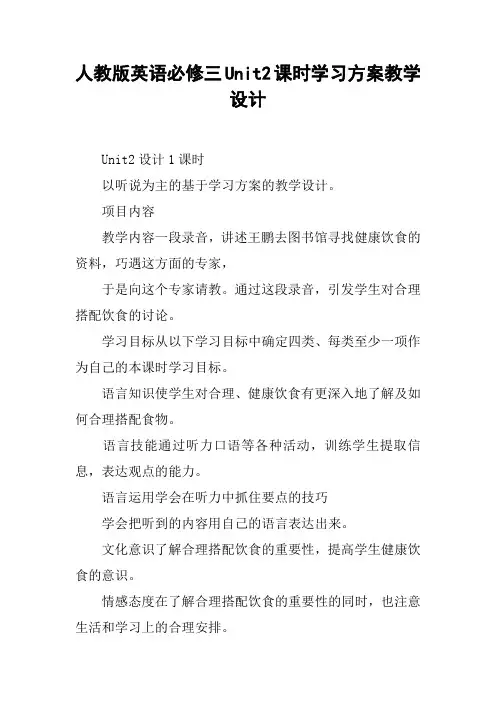
人教版英语必修三Unit2课时学习方案教学设计Unit2设计1课时以听说为主的基于学习方案的教学设计。
项目内容教学内容一段录音,讲述王鹏去图书馆寻找健康饮食的资料,巧遇这方面的专家,于是向这个专家请教。
通过这段录音,引发学生对合理搭配饮食的讨论。
学习目标从以下学习目标中确定四类、每类至少一项作为自己的本课时学习目标。
语言知识使学生对合理、健康饮食有更深入地了解及如何合理搭配食物。
语言技能通过听力口语等各种活动,训练学生提取信息,表达观点的能力。
语言运用学会在听力中抓住要点的技巧学会把听到的内容用自己的语言表达出来。
文化意识了解合理搭配饮食的重要性,提高学生健康饮食的意识。
情感态度在了解合理搭配饮食的重要性的同时,也注意生活和学习上的合理安排。
学习策略自主地在新旧语言知识之间建立联系,自主反思本单元所学到的语言知识和技能,将之迁移并运用到要学习中,主动拓展与本单元主题相关的信息。
任务课时任务:听一段录音,获取相关语言信息,再把这些信息运用在口语活动中,给一个胖女孩提一些饮食方面的建议。
评价标准从以下标准中选定至少两项作为你本单元学习的评价标准。
理解听力材料的大概内容。
能把所听到的信息运用到口语中。
借助同伴的启示与帮助,更好的完成任务。
学习资源听力材料预设时间学习步骤学习目的教学方案学习方案学习资第1-5’导入引入听力老师会用两个问题”hichillnessdoestillhavetoday?“and “hyehavethisillness?”引导学生进入听力材料,让学生对接下来的听力训练的内容有一个心里准备。
用问题激发学生的讨论,从而激发学生对回答问题及相关知识的联想。
学生通过讨论为接下来的听力任务做好背景知识准备。
教师话语第6-21’听力进入听力训练,本课时的重点之一有了前面两个问题引入,再加上前面学过的READING部分,教师可以直接进入主题。
让学生听一段录音之后,学生完成几个简单的问题,再听一遍录音,再完成几个细节题,循序渐进,由浅入深,学生可以大概获取听力材料的信息。
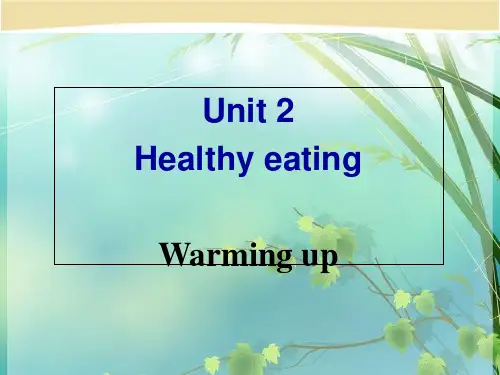
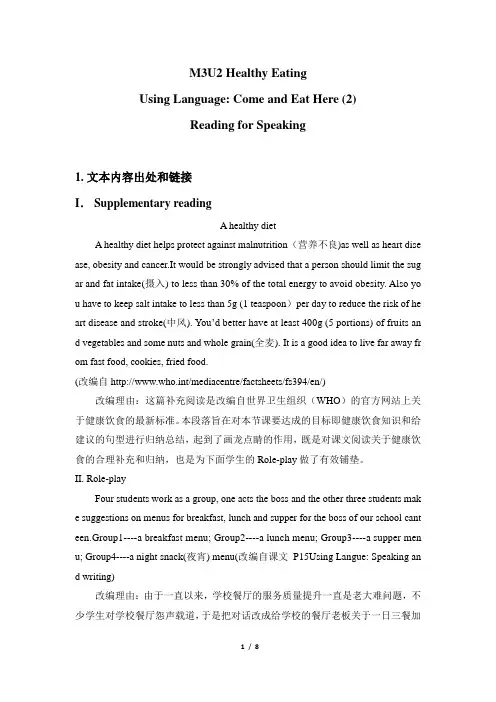
M3U2 Healthy EatingUsing Language: Come and Eat Here (2)Reading for Speaking1. 文本内容出处和链接I. Supplementary readingA healthy dietA healthy diet helps protect against malnutrition(营养不良)as well as heart dise ase, obesity and cancer.It would be strongly advised that a person should limit the sug ar and fat intake(摄入) to less than 30% of the total energy to avoid obesity. Also yo u have to keep salt intake to less than 5g (1 teaspoon)per day to reduce the risk of he art disease and stroke(中风). You’d better have at least 400g (5 portions) of fruits an d vegetables and some nuts and whole grain(全麦). It is a good idea to live far away fr om fast food, cookies, fried food.(改编自http://www.who.int/mediacentre/factsheets/fs394/en/)改编理由:这篇补充阅读是改编自世界卫生组织(WHO)的官方网站上关于健康饮食的最新标准。
本段落旨在对本节课要达成的目标即健康饮食知识和给建议的句型进行归纳总结,起到了画龙点睛的作用,既是对课文阅读关于健康饮食的合理补充和归纳,也是为下面学生的Role-play 做了有效铺垫。
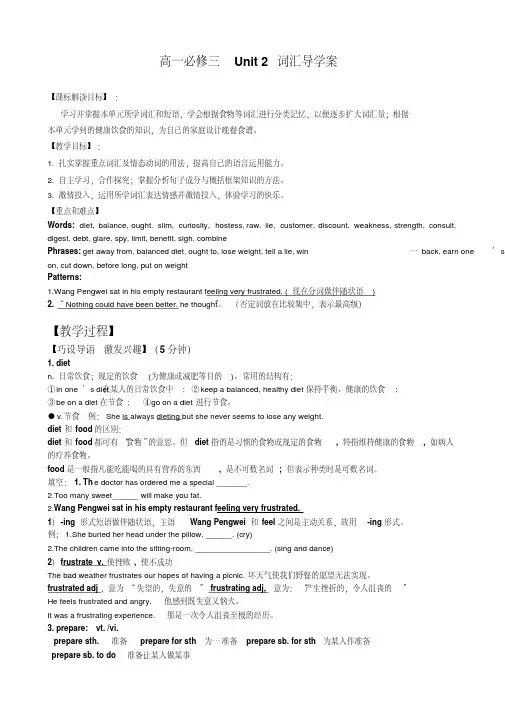
高一必修三Unit 2 词汇导学案【课标解读目标】:学习并掌握本单元所学词汇和短语,学会根据食物等词汇进行分类记忆,以便逐步扩大词汇量;根据本单元学到的健康饮食的知识,为自己的家庭设计晚餐食谱。
【教学目标】:1. 扎实掌握重点词汇及情态动词的用法,提高自己的语言运用能力。
2. 自主学习,合作探究;掌握分析句子成分与概括框架知识的方法。
3. 激情投入,运用所学词汇表达情感并激情投入,体验学习的快乐。
【重点和难点】Words: diet, balance, ought, slim, curiosity, hostess, raw, lie, customer, discount, weakness, strength, consult,digest, debt, glare, spy, limit, benefit, sigh, combinePhrases: get away from, balanced diet, ought to, lose weight, tell a lie, win… back, earn one’s on, cut down, before long, put on weightPatterns:1.Wang Pengwei sat in his empty restaurant feeling very frustrated. (现在分词做伴随状语)he thought。
(否定词放在比较集中,表示最高级)2. “Nothing could have been better.”【教学过程】【巧设导语激发兴趣】(5分钟)1. dietn. 日常饮食;规定的饮食(为健康或减肥等目的)。
常用的结构有:①in one’s diet在某人的日常饮食中; ②keep a balanced, healthy diet保持平衡、健康的饮食;③be on a diet在节食; ④go on a diet进行节食。
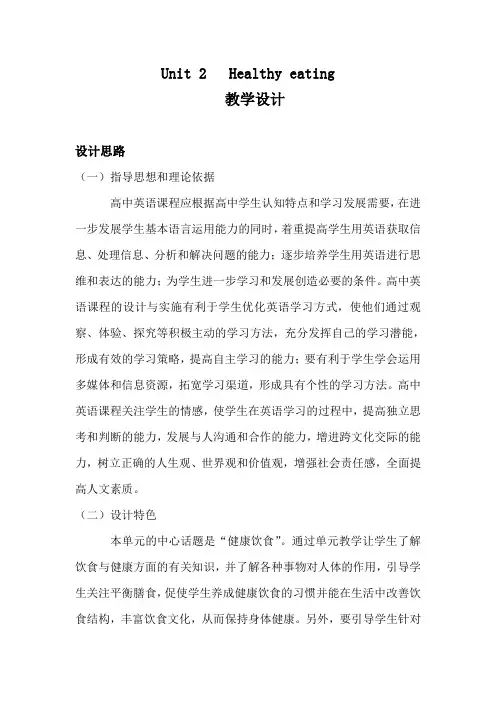
Unit 2 Healthy eating教学设计设计思路(一)指导思想和理论依据高中英语课程应根据高中学生认知特点和学习发展需要,在进一步发展学生基本语言运用能力的同时,着重提高学生用英语获取信息、处理信息、分析和解决问题的能力;逐步培养学生用英语进行思维和表达的能力;为学生进一步学习和发展创造必要的条件。
高中英语课程的设计与实施有利于学生优化英语学习方式,使他们通过观察、体验、探究等积极主动的学习方法,充分发挥自己的学习潜能,形成有效的学习策略,提高自主学习的能力;要有利于学生学会运用多媒体和信息资源,拓宽学习渠道,形成具有个性的学习方法。
高中英语课程关注学生的情感,使学生在英语学习的过程中,提高独立思考和判断的能力,发展与人沟通和合作的能力,增进跨文化交际的能力,树立正确的人生观、世界观和价值观,增强社会责任感,全面提高人文素质。
(二)设计特色本单元的中心话题是“健康饮食”。
通过单元教学让学生了解饮食与健康方面的有关知识,并了解各种事物对人体的作用,引导学生关注平衡膳食,促使学生养成健康饮食的习惯并能在生活中改善饮食结构,丰富饮食文化,从而保持身体健康。
另外,要引导学生针对现实中遇到的实际问题发表自己的看法。
通过合作式、探究式学习方式,激发学生的学习兴趣,使学生由被动变主动,积极参与学习过程。
教材分析(一)教材处理在本节阅读课前,先进行词汇教学,然后围绕中心话题Healthy Eating 复习与学生的生活实际息息相关的食物,然后向本单元词汇过渡。
在阅读过程中,笔者根据学生认知特点和实际情况,把教材中的Warming up作为Reading的导入部分,把Pre-reading,Reading和Comprehending整合在一起作为一堂“精读课”。
(二)教学目标(1)熟悉有关食品的各种词汇,对比中餐和西餐的区别。
根据不同食品对人身体的不同影响,使学生对合理饮食、饮食习惯、饮食结构与饮食文化有更深入地了解,倡导健康饮食。
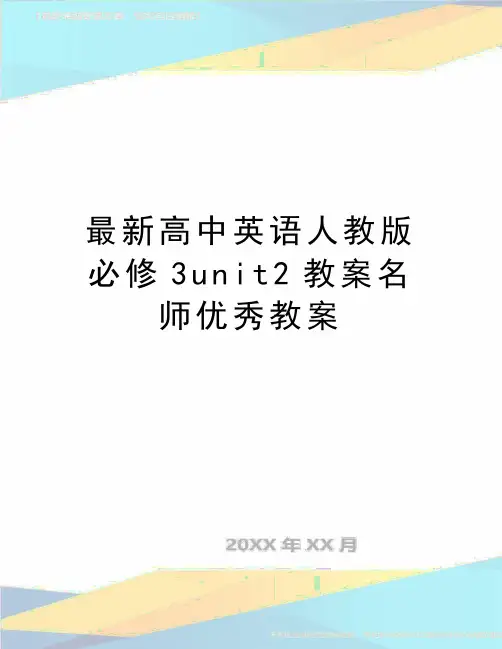
最新高中英语人教版必修3u n i t2教案名师优秀教案高中英语人教版必修3unit2教案Unit 2 Healthy eatingWarming up, pre-reading and readingTeaching aims1. Get students to read the passage and learn the different reading skills.what it 2. Enable students to learn about the importance of healthy eating and knowhealthy diet.3. Develop students’ sense of cooperative learning. Teaching importance1. Let students read the passage and learn something about healthy eating.2. Get students to learn different reading skills.Teaching difficulties1. Develop students’ reading ability.2. Enable students to learn to talk about the food and our daily diet. Teaching methods1. Task-based teaching and learning2. cooperative learning3. DiscussionTeaching proceduresStep1 Warming up1. Match the food with the festivals.We have leant something about festivals in last unit. Do you know what do we usuallyeat during each festival?Moon cake Lantern FestivalZongzi Spring FestivalDumplings Thanksgiving DayYuanxiao Dragon Boat FestivalChocolate Mid-autumn FestivalTurkey St Valentine’s DayPumpkin Halloween2. Discussion1. What do you usually eat every day?2. What is your favourite food?3. Do you think your diet is healthy?Step 2 Pre-readingImagine you have a restaurant, what kinds of food will you provide to your customers?Step 3 ReadingTask 1 Fast readingScan the text and then choose the best answer according to the text. 1. Why did Wang Peng feel it hadbeen a very strange morning? A. what he had prepared was sold out.B. Few people walked into his restaurant to eat.C. He couldn’t make his restaurant more beautiful.D. He didn’t know how to make delicious food.2. Where did the customers go to eat instead of going to Wang Peng’ s restaurant?A. They ate at home.B. They went to a new big restaurant to eat.C. They ate in a new small restaurant.D. They wanted to eat something rich in fat in another place.3. What is Wang peng’ s impression on Yong Hui’ s restaurant?A. All the customers in it were very slim.B. It was too small and too noisy.C. The food in it was very nice and better than that in hisD. There was so limited food but the price was much higher.4. What was the disadvantage of the food offered by Yong Hui’ s restaurant?A. It had too much fat.B. It couldn’t make people lose weight really.C. It could make people ill.D. It couldn’t offer people enough energy.5. We can infer from the last sentence that ____A. Wang Peng and would learn from Yong Hui.B. Yong Hui would learn from Wang Peng.C, The competition had begun and would continue.D. The two restaurants would give up the competition.Task 2 Careful readingThe test can be divided into three parts. Listen to the tape of each part and find out the main idea of each part. Then use about 30 words to sum up the main idea of this passage.Part 1 (para 1)Part 2 (para 2-3)Part 3 (para 4)According to the passage, we know that Wang Peng’ restaurant became _____because a new one had taken his regular _____ away, and he wanted to _____ it to win his customers back.Task 3 SummaryWang Peng felt frustrated because his ______(custom) didn’t come to eat at hisrestaurant ____ usual though he prepared a perfect menu. When his friend Li Chang passed by his restaurant ________ coming into his restaurant to eat as he always did, Wang Peng felt that something terrible must _______. So Wang Peng followed him to a newly-opened small restaurant with a sign in the window. The sign said in this restaurant people tired of fat could be served slimming foods only and would become_____ (thin) soon. With ____ (curious), Wang Peng entered and was shown a menu by a thin lady named Yong Hui. On the menu, there were only rice, raw vegetables, fruit and water. After _____ (leave) the restaurant, he decided to do some research. Soon he found that Yong Hui’ s restaurant did n ot serve energy-giving foods and the customers would become _______(tire) quickly. So he put up a new sign _____ saidhis restaurant would serve foods providing all-day energy. The ________ between the two restaurant was on.Step 4 HomeworkFind out the useful words, expressions and sentence structures in thepassage.。
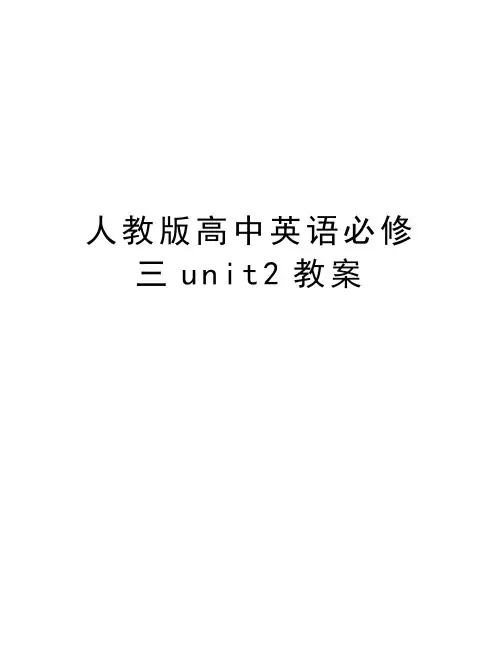
人教版高中英语必修三u n i t2教案Unit 2. Healthy EatingTeaching aims and demands:1.Topics:Problems with diet ;Balanced diet and nutrition2.Words and expressions3.Functions:1)Suggestions and adviceYou must /must not… ; What should I do?I think you ought to …; I suppose you had better…Perhaps you should…Do you think you could give me some advice?2)Seeing doctorsWhat’s the matter? What’s wrong?What seems to be the trouble?How long have you been like this?3)Agreement and disagreement.I don’t agree. Of cause not. I don’t think so.All right. That’s a good idea.No problem. Certainly /sureYes, I think so. I’m afraid not.4. Grammar: The use of ought toYou ought to cook fresh vegetables and meat without too much fat If you want to stay slim.You ought not to eat the same kind of food at every meal.Period 1Vocabulary重点词汇1. balance n. 天平,平衡;余额,余数 v. 平衡;权衡 balanced adj. 均衡的[典例]1). Try to achieve a better balance between work and play. 争取把工作和娱乐更好地结合起来。
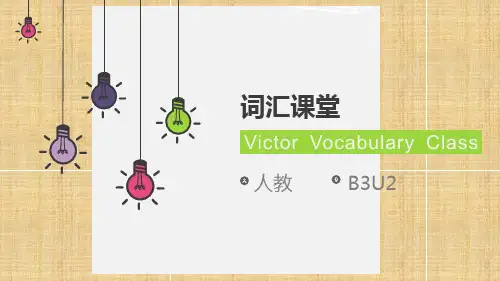
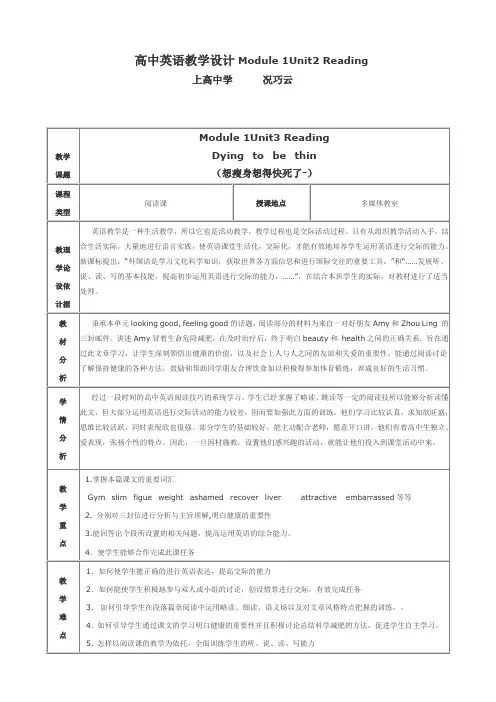
高中英语教学设计Module 1Unit2 Reading 上高中学况巧云TeachingProcedures教学过程设计All the class is set in the TV interview show—Heart Garden made by channel Young.De tailly, I divide the class in to three groups as the guests of this TV interview show:Frend s of the character, Nutritionists, Psychologists. The teacher play the role of the host Step1 Lead--in1.Broadcast the VCR----Are teens trying to stay slim to an extreme from BBC ,then trans pose to our calss,which can lead students to the TV show situationT: “Good moring ,Ladies and Gentleman! Welcome to Heart Garden made by Channel YOUNG STV .I am the host.Today’s topic is Dying to be thin. There are three groups :Frends of the chara cter, Nutritionists, Psychologists.Let’s talk together to slove the problem today.Finally, let’s see which group can get the most stars accroding to your active cooperation.Are you r eady? ”S: “Yes! ”.T: “First ,let me show you some picutes.Do you know them”Show students some pop stars’picturesT: “Whom do you like better, the thin or the fat? How can we become thin?S: “The thin.”T: “How can we become thin?Let’s discuss ways of losing weight.”Suggested answers:Going on a diet Exercising in a gym or other places Receiv ing surgical treatment(外科治疗) Taking weight-loss pillsT: Do you think eating weight-loss pills is effective and good?”S: “ No!’T: “ Good!But the unfortunate thing also happened to our character--Amy .Let’s welcome A my.”设计意图:把正堂课虚拟上海生活时尚频道---心灵花园节目的录制现场。
Unit2 Grammar 名师教学设计(一)高一年级英语学科必修三Teaching Important & Difficult PointsHelp the students learn modal verbsHow to help the students to improve their learning abilityTeaching MethodsTask-based learning; cooperative learningTeaching AidsA multi-media computer and blackboardThree Dimensional Teaching AimsKnowledge and SkillsHelp the students to improve the skills to grasp the grammar rulesProcess and StrategiesIndividual work to finish each taskThe teacher may play a role in leading the studyFeelings and ValuesThe grammar material in this unit is modal verbs. It can bring the students quite a lot of usage.Teaching ProceduresStep 1 Greeting and check the homework.Step 2 check the preview.Task 1 Analysis the meaning of the underlined part in each sentenceTask 2 Try to translate these sentences.1.I knew that I ought not to open the letter, so I didn’t.答案:不应该;我知道我不应该打开信件,所以我没有打开。
Unit2 词汇课名师教学设计(一)Book3 Unit 2 Healthy EatingPeriod 2 Learning about languageAnalysis of the teaching materials (教材分析)This is the second period of unit 2, which centers on the vocabulary and grammar .After students read the stories Come and eat here I&II, they will learn words and exp ressions about healthy eating. This period will help them consolidate vocabularies the y learn in the story. For the grammar, the exercise will help students review the functi on of modal verbs and explain the meaning in context.Analysis of the students(学情分析)Students have learned the basic function of modal verbs in unit 1, so it will not b e too difficult for them to finish the task. Students learn a lot of words about various k inds of topic, but they have no idea of how to keep so many words in mind. In this per iod, a word bank will be recommended for them. They should learn to sort out the wor ds according to different topics and this will help them memorize vocabularies. Teaching objectives (教学目标)At the end of the period, the students will be able to...1. Language knowledge (知识目标)learn to talk about what a healthy diet is by using the words and expressions: balanced , raw, diet, slim, energetic, lose weight...2. Language skills (能力目标)understand the functions of modal verbs in context and use modal verbs to express ne cessity, advice and ability.3. Emotional cultivation (情感目标)examine their own eating practices and see whether they are eating healthily4. Learning strategies (策略目标)solve the problem individually and accomplish the task cooperatively.Teaching key points (教学重点)To get the students to talk about keeping healthy and slim by using target words Teaching difficult points (教学难点)To get the students to understand the functions of modal verbsTeaching methods (教法):Guided learning method: discover the structure with the help of the teacher. Learning methods (学法):Set up a word bank and learn to categorize wordsTeaching procedures (教学过程)Step 1 Review and paraphraseReview the words in the passage1. Ask students to guess the words according to the pictures and description.○1_____ (adj.) food is food that is eaten uncooked. ○○2A __________(adj.) diet is a healthy diet with energy-giving food, body-building fo od, and protective food.○3A _____(adj.) person has an attractively thin and well-shaped body. ○○4Every time Pinocchio tells a ______(n.), his nose will grow. ○○5A ________(n.) is someone who buys goods or services from a shop. ○○6A ________(n.) is a reduction in the usual price of something. ○○7_________(n.) is a strong wish to know about something. ○○8The ________(n.) of something is the help that you get from it or the advantage tha t results from it.○9If you are on a _____ (n.), you eat special kinds of food or you eat less food than u sual because you are trying to lose weightAnswers: raw, balanced, slim, lie, customer, discount, curiosity, benefit, diet2. Ask students to fill in blanks with the words given.raw benefit curiosity lie customerWhen Wang Peng saw Yong Hui's sign, ________ drove him inside. Yong Hui'smenu has just rice, _____ vegetables, fruit and water on it. He thought he could not ha ve her getting away with telling people ______! After doing some research, he decide d to advertise the ______ of his food and wanted to win _________ back. Answers: curiosity, raw, lies, benefit, customers3. Paraphrase the words (Ex1 on Page12)When Wang Peng saw Yong Hui's sign, curiosity drove him inside. Yong Hui's menu has just rice, raw vegetables, fruit and water on it. He thought he could not hav e her getting away with telling people lies! After doing some research, he decided to a dvertise the benefit of his food and wanted to win customers back.○1something that you say that you know is not true. ○○2not to be punished for something ○○3uncooked ○○4the strong wish to know about something ○○5someone who buys things or services from a shop, company, etc. ○○6a particular quality that gives someone or something an advantage. Answers: lie, ge t away with, raw, curiosity, customers, benefit,4. Set up a word bank设计意图:首先,通过借助图片和提示,让学生猜测词汇,丰富的图片可以激发学生的兴趣,同时给予一个直观的印象,而提示则通过挖空该词汇的英文解释,也提供了一定的语境,让学生更全面地了解该词汇的含义。
引入本节课侧重所学的词汇后,让学生及时操练,用这些词汇完成短文填空,短文是对课文的故事情节的总结,通过填空也帮助学生回忆了课文故事的提要。
在这个引入和操练的过程中,帮助学生学会根据话题建立一个word bank,归类话题相关词汇,同时针对这些词汇进行填空复述,巩固所学,最后完成课文第一个练习选择用英文解释词汇的含义,培养学生用英语思考的能力。
Step 2 Critical thinkingCritical thinkingQuestion 1: Can people become slim after eating Yonghui's food?Finish Ex2 and read the story about Julie and you may know about the answer.Julie wanted to become thinner. She knew she ________ eat more vegetables and fruit but little meat. However, as she was so afraid of being laughed at by her friends, she did not consult a doctor but lived on a _____ of rice, ____vegetables, bananas and lemons. Three weeks later, she found she weighed as much as ever. She felt so sad an d hopeless about herself and her behaviour changed. She didn't dare to face her boyfri end and she was unwilling to visit her friends any more. Luckily, her best friend Fred came to see her and encouraged her to exercise, eat a _______diet and enjoy life again . Soon Julie became amazingly ______ and _____! She felt very happy. Question: What did Julie eat? Can Julie become slim? What else did she have to do? Possible answers: She lived on a diet of rice, vegetables, bananas and lemons, just like the food in Yonghui’s restaurant. Julie ca n’t lose weight by living on a diet. She had t o do exercise as well.Conclusion: A balanced diet with proper exercise will help.Question 2: Why can Yonghui win a lot of customers? Read the lines picked from the passage and find the reasons.Line 11: Wang Peng followed Li Chang into a small new restaurant.Reason: Customers may go to a new restaurant out of curiosity.Line12-15: Yonghui's signReason: Customers will be attracted by a good advertisement.Line 16: It(her restaurant) was full of peopleReason: Customers may follow the herd and lose interest in an empty restaurant. Line 23:It cost more than a good meal in his(Wang Peng’s)restaurant.Reason: Customers may think that expensive food tastes better.Conclusion: Yonghui knows about customers’ need better.Share business quotes:(1)The customer is always right.(2)Your most unhappy customers are your greatest source of learning.(3)Don’t find customers for your products; find products for your customers.设计意图:批判性阅读是针对文本挖掘,对话题进行拓展和补充,第一个设问是针对Yonghui的餐厅通过只吃水果蔬菜的方式来减肥的有效性来提问的,引出课文第二个练习,Julie通过这种方式减肥失败的故事,来引导学生明白合理的减肥方式应该是平衡膳食和运动锻炼相结合。